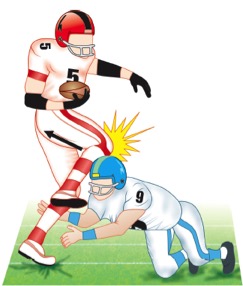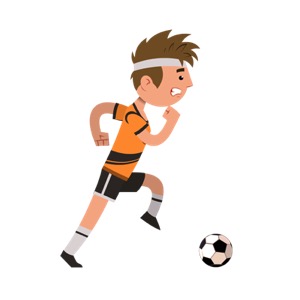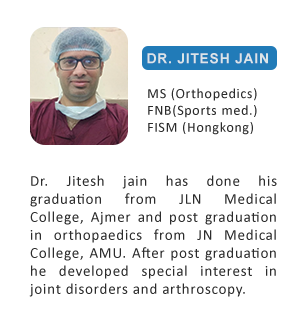Prevention of Sports Injuries
Prevention is better than cure. Nowadays, lots of athletes want to know about the prevention of sports injuries. Sports are the most common recreational activities. The participation of children and adolescents in sports is encouraged by parents and schools as it decreases the chances of obesity, diabetes, hypertension, and promotes mental, physical, and cardiac health. However, sportspersons are at increased risk of getting injuries as they undergo intense physical training to acquire high-grade skills.
The wrong technique, overzealous training, lack of proper warm-up and cool down, decreased flexibility are among important causes of sports injuries in both amateur and professional sportspersons. Many sports injuries can cause permanent disability and even terminate the carrier of a sports person, therefore sports injury prevention and execution of safe training and wright technique is of paramount importance.
Types of sports injuries:
Common sports injuries can be divided into two types, acute and chronic. Acute injuries include muscle sprain, muscle bruises, tear of ligaments and tendons, fracture and joint dislocations, etc.

Chronic sports injuries are overuse injuries which occur due to repetitive strain to bone, muscle, tendon or ligament. Common examples of chronic overuse injuries include, tennis elbow (pain at outer side of elbow), Golfer's elbow (pain at inner side of elbow) plantar fasciitis ( heel pain at bottom of heel), TA tendonitis (back of heel pain), Biceps tendinitis (shoulder pain), dequervain's tenosynovitis ( wrist pain), shin splints (leg pain in runners) and stress fractures etc.
Planning to begin sports:

Choose right sports: Not everyone is meant for all sports, for example if you are 40 years or above and thinking of beginning a sports or any intense physical activity, make sure that you don't have cardiac or respiratory risk factors. If you have knee joint pain, jogging, treadmill, skipping rope can make it worse. If you have been diagnosed with heart or lung disease, or if you have diabetes ask your physician before starting sports activity. Similarly if a child has flat feet, it may hamper performance in short explosive events like sprint and long distance endurance running.
Make your body flexible: stretching exercises lower the risk of muscle injury. It also reduces muscle soreness after sports and intense exercises and improves athletic performance. Flexibility also decreases the chances of reinjury after recovery from a sports injury. Stretching increase the joint range of motion and help getting balance and coordination thus decrease the chances of injury from fall.
Warm up and cool down: Always start slow and gradually increase the intensity of workout. Warm up sessions should last from 15 to 30 minutes. Usually these sessions include cardiac and stretching exercises. Warm-up prepares the body for the game by gradually increasing the heart rate and blood circulation to the muscles. Warm-up increases the blood supply and temperature of large muscles, ligaments and tendons, improve their elasticity and prepare the body physically and mentally for the sports and prevents injury. Keeping the muscles warm decrease chances of muscle sprain and delayed muscle soreness. In the warm-up session after stretching/jogging slowly rehearse the game you will be playing. Cooling down is equally important to prevent sports injuries. Don't abruptly end your workout and gradually decrease the intensity of workout in last minutes. This will help the body to restore normal heart rate and blood pressure.
Learn proper technique: Proper technique is equally important for both recreational and professional sports. Wrong technique of service in racket sports and improper landing in field sports are among the most common causes of sports injuries. Some useful tricks and technique are given below for common sports:
- Bicycling: Ride in an upright position if possible. Adjust the saddle height. Best way to adjust it is heel to paddle method. Place your heel on the pedal and pedal backward to reach the six o'clock position. Your knee should be completely straight if your addle height is proper. To prevent overuse injuries of elbow and shoulder, frequently change the position of handlebars.
- Running: Begin with straight-line jogging and gradually increase the distance and speed. In the beginning, running too fast and running too long, both are harmful. Build your stamina to run long distances before attempting to run those distances fast. Never run with worn-out shoes and replace your running shoes after every 400 to 500 miles of running. Always look ahead and don't stare at your feet to avoid falling. Keep your arms bent 90 degrees at the elbow and sway them at waist level. To prevent injuries to your lower body, use a midfoot strike, and avoid hitting the ground with your heel.
- Tennis: Proper technique of service is very important to avoid overuse injuries like tennis elbow and biceps tendinopathy. Anyone with any type of pre-existing wrist or forearm deformities/pain should not play racquet sports. Always try to strike from the middle of the racket. Avoid landing on the heels. Start backhand swings from your shoulder and not from the elbow or wrist. When serving, bend your knees and raise your heels, distributing your weight evenly over your heels.Choose the correct size of handgrip (one way is to measure the tip of the ring finger to the last palmar crease), racquet size (27-29 inches for an adult) and string tension (average string tension runs anywhere from 55 to 65 pounds)Don't ignore your symptoms following injury. Most of the sports injuries can be treated conservatively. Consult a sports injury specialist in time as continued playing with injury makes it worse only.
ABOUT THE AUTHOR

TESTIMONIAL

मेरा दाए पैर में चोट लगने के कारण टेढ़ा हो गया था जिसकी वजह से मुझे चलने में भी परेशानी हो रही थी. डॉ जितेश ने ऑपरेशन कर के इसे सीधा किया. में बिलकुल ठीक हूँ .

मेरी बेटी के घुटने में इन्फेक्शन होने के कारण वो दर्द की वजह से सो भी नहीं पाती थी. डॉ जितेश ने ऑपरेशन कर के इसे ठीक किया. बहुत धन्यवाद।

I remember that Dr. Jain came out from his clinic to see my mother because my mother was not able walk a single step. He did total knee replacement on both side and now my mother is walking without aid.
OPENING HOURS
| Monday – Friday | 17:00 – 20:00 |
| Sunday | OFF |
